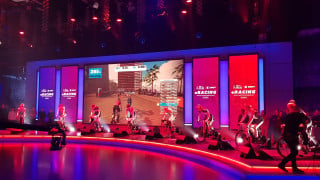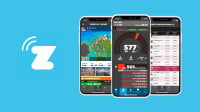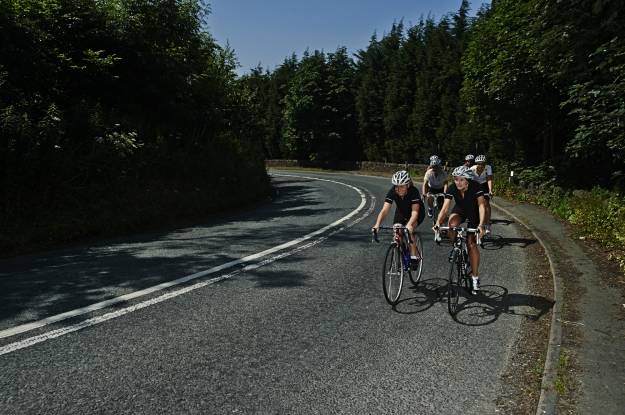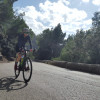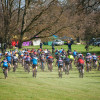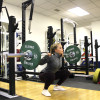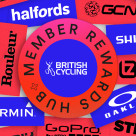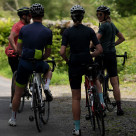If you’re looking for extra motivation for your indoor training, entering a race on Zwift could be just the boost you’re looking for. Many top riders use it to supplement their training and a lot have claimed they go deeper virtual racing than they do on the road. There are races for all levels of riders and, without having to leave your own home to pin a virtual number on, you won’t find a more accessible and convenient form of cycle sport.
Picking your race category
Races in Zwift are usually organised into categories from A to D with A being the fastest. There are also a few Elite level races for top riders only. Although there might be racers of other categories visible, you’re only usually competing against other riders in your category. The exception to this is if a race is only listed as having an A or E group and that means everyone is competing together.
The most commonly used categories are based on your Functional Threshold Power (FTP) in w/kg. There are a number of ways to test for your FTP, including our Threshold Test or you can test on Zwift. Once you know your FTP, simply divide it by your weight. For example, if your FTP is 250 watts and you weigh 80kg, your w/kg is 3.1.
The w/kg category bands are:
A = 4.0 w/kg >
B = 3.2 - 3.9 w/kg
C = 2.5 - 3.1 w/kg
D = < 2.4 w/kg
There’s no doubt that it can be tough if you find yourself at the lower end of a category band but don’t be tempted to “sand-bag” and enter a lower one. You’ll find as you gain fitness and experience that you’ll soon find yourself improving.
Finding a race
There are a few ways to find and sign-up for a Zwift race. You can use the Events tab on the Zwift Companion app, go to the events page on Zwift.com or in-game.

Races vary massively in duration from short 20-minute blasts around Crit City to climbing epics up the Alpe Du Zwift.
For something a bit different, you can try Zwift HQ FurtureWorks races which trial new features in development such as Boost Mode, Anti-Sandbagging and Steering.
There are also a few different race formats including time trials and handicap races.
Try a few and you’ll soon find the races and courses that suit your style of riding best.
Be prepared
Don’t leave getting your bike set-up until the last minute. Ensure you’re well hydrated, towel and fan ready, all devices charged and connected and the app all loaded and ready to go with plenty of time to spare.
Allow yourself enough time for a decent warm-up. You can do this in a different World from your race and will automatically be transported to the race pen in time for the start. While waiting in the pen, you’ll be on a “turbo trainer” in-game and can keep your legs spinning.
Start with a bang
You’ll get a countdown but don’t wait for zero to make your jump. Zwift races always start really hard so you need to be up to power when the flag drops. Don’t be surprised if your race starts well above your w/kg category, just find a wheel, dig in and it will settle down after a couple of minutes. The exception to these flat out starts are handicap races, where you’ll be working with your category grouping to catch the groups ahead and to stay away from the groups chasing behind. However, even on these races, you still want to be spinning before the gun.
Draft
There’s a surprising amount of skill and technique to racing on Zwift, especially with regards to maximising the draft from other riders and conserving energy in the bunch. It takes practice but a good tip is to keep an eye on the w/kg of the riders around you and try to consistently match it. Avoid surging as that’ll throw you off the front into the wind and then, if you back off, you’ll fall through the bunch and be spat out the back.
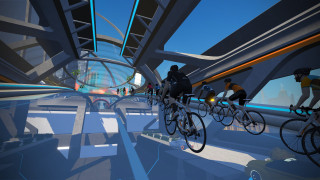
Power-ups
Although they don’t feature in some races, in the vast majority they do and play a big role in deciding the final outcome. Power-ups are randomly given when you go through and arch (start/finish, end of KOM, end of sprint). If you already have a power-up in your jersey pocket, you don’t get a new one.
You activate a power-up by using the spacebar on your keyboard or the button on the Zwift Companion App.
There are seven power-ups but the Large Bonus and Small Bonuses are useless in a race and just give you extra experience points.
The Power-ups you need to be aware of are:
Aero Boost (helmet): Makes you more aero for 15 seconds. Use on flats, descents and for finishing sprints. It’s rare that a Zwift sprint is won without an aero boost so, if you get one, it can be worth holding it until the end of the race.
Lightweight (feather): Reduces your weight by 9kg for 15 seconds. Use on climbs.
Draft Boost (van): Doubles the draft effect for 30 seconds. Use on flats and descents when you’re in a bunch or following another rider.
Cloaking (ghost): Makes you invisible to other riders for 10 seconds. Use to sneak off the front without other riders noticing.
Burrito: Makes you un-draftable for 10 seconds. Use when attacking off the front of the bunch.
Race and recover
Racing on Zwift is a lot of fun and can be very addictive. However you will be spurred into giving your all and, although this means a great workout, you need to be careful about overdoing it.
Track your riding on a platform such as TrainingPeaks and ideally incorporate your Zwift races into a structured training plan. If your following one of our Digital Training Plans each of the workouts has a Training Stress Score (TSS) and you will also get this metric from your Zwift races. See how the scores tally and adapt your plan accordingly.
To perform at your best on Zwift and get the most out of your indoor cycling, download our free Ultimate Guide to Indoor Training eBook.

